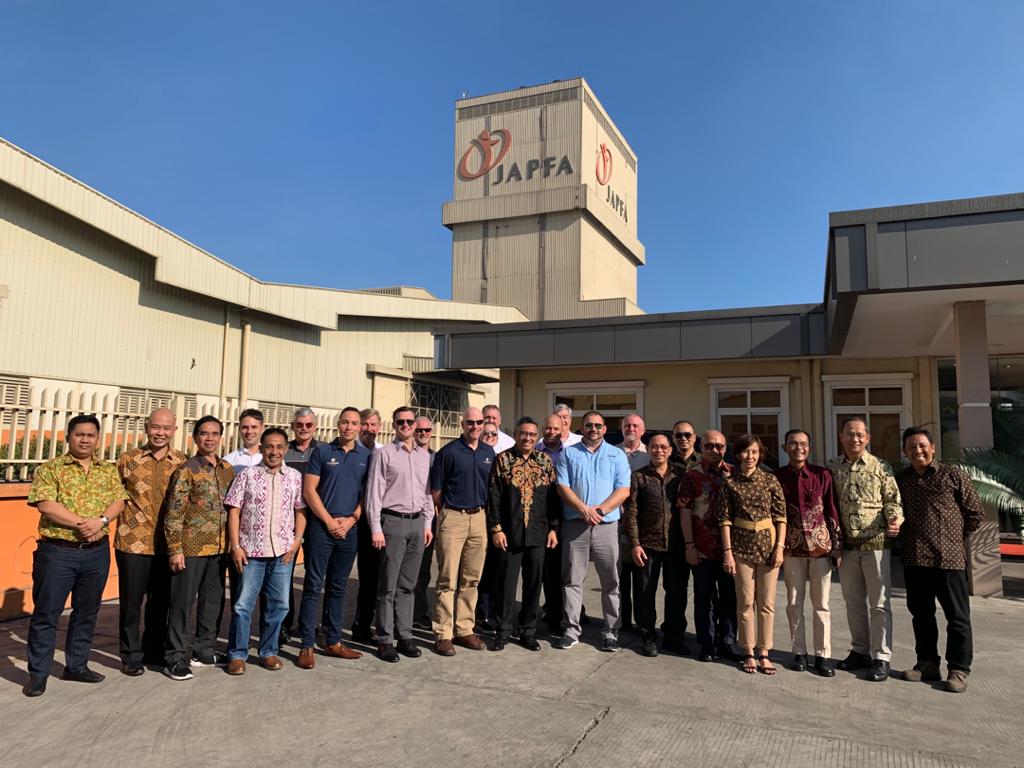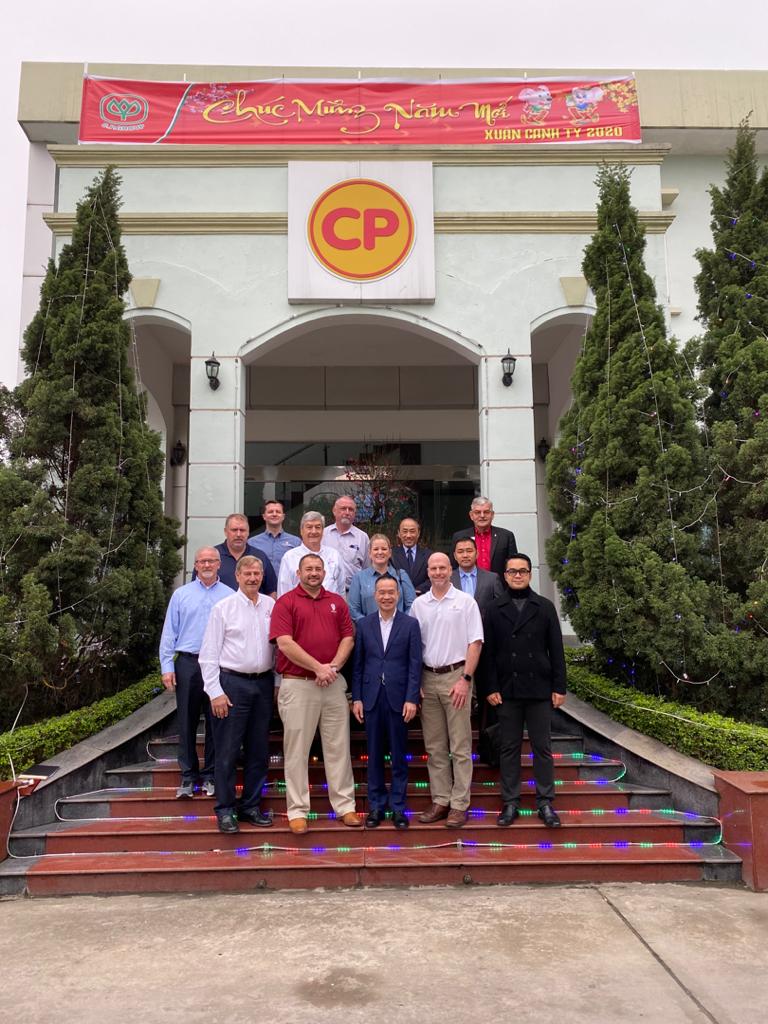The breadth and depth of the Southeast Asian market for U.S. corn and co-products are hard to imagine, but the incredible innovation and regional demand potential is plain to see once on the ground – as the leaders of the U.S. Grains Council (USGC) and National Corn Growers Association (NCGA) learned firsthand last week during a joint officers mission to Vietnam and Myanmar.
“Southeast Asia is a dynamic, growing region for U.S. coarse grains and co-products,” said Darren Armstrong, USGC chairman and farmer from North Carolina. “Witnessing the technological advancements of the Vietnamese industry and the growth expectancy of feed demand in Myanmar allowed these industry leaders to gain the perspective of our customers and end-users on the ground in Southeast Asia.”
The Council delegation included Armstrong; Jim Raben, USGC vice chairman and farmer from Illinois; Chad Willis, USGC Secretary/Treasurer and farmer from Minnesota; Jim Stitzlein, USGC past chairman; and Ryan LeGrand, USGC president and chief executive officer. The leaders were joined in country by Manuel Sanchez, USGC regional director for Southeast Asia, and Caleb Wurth, USGC assistant regional director for Southeast Asia.
NCGA representatives included Kevin Ross, NCGA president and farmer from Iowa; Lynn Chrisp, NCGA chairman and farmer from Nebraska; John Linder, NCGA first vice president and farmer from Ohio; Jon Dogget, NCGA chief executive officer; and Brooke Appleton, NCGA vice president of public policy.
“This joint mission was a welcome opportunity to join fellow NCGA and USGC officers to learn more about this important market and continue our efforts to build on our existing trading relationship,” Ross said.
During the mission, the group met with key current and future customers in the region, including fuel retailers, feed millers, commercial livestock operations, grain traders and other key agribusiness representatives. The U.S. leaders also met with local government representatives as well as the officials from the U.S. Department of Agriculture’s Foreign Agricultural Service (USDA’s FAS) working in each country.
“FAS posts all around the region serve as partners and collaborators in all of the in-country programs we conduct,” Armstrong said. “The Council’s outstanding relationship with USDA officials allows us to be successful in our overall mission.”
Vietnam – A Long-Time Market With Continued Growth Potential
Vietnam is one of the fastest growing feed markets in the world – thanks to population and economic growth – and a major buyer of corn and dried distiller’s grains with solubles (DDGS). Ranking as the second largest buyer of U.S. DDGS, Vietnam set a new record for DDGS imports in 2018/2019, increasing purchases by 24 percent year-over-year to nearly 1.3 million metric tons, valued at $278 million. Vietnam has also jumped from the 16th largest importer of corn in the world to the third largest – in less than a decade.
The Council has actively worked with the Vietnamese grain trade and feed industry for more than two decades. The Council’s technical programs in Vietnam have focused on helping livestock producers and feed millers effectively use U.S. coarse grains and manage their operations efficiently. Trade servicing has also helped these customers gain familiarity with the U.S. grain marketing system, quality and price.
“It has only been 25 years since the United States normalized relations with Vietnam,” LeGrand said. “The Council has been there since the beginning with an in-country representative.”
In Vietnam, the joint officers mission explored the integrated supply chain of the world’s largest feed manufacturer by volume – touring one of their feed production and meat processing facilities.
“These end-users provided valuable insight into what they need to increase demand for coarse grains and co-products like DDGS,” Armstrong said. “This understanding will help shape the Council’s strategy for developing programs in these markets.”
Vietnam also shows great promise for ethanol exports. The country currently allows up to an E5 blend and is working toward a goal of adopting an E10 mandate by 2020, but ethanol import duties prevent the United States from capturing additional market share.
During meetings with government officials and fuel retailers, the delegation reiterated the need for Vietnam to reduce this import tariff to stimulate demand and improve the affordability of ethanol-blended fuels for Vietnamese customers. These meetings help build on a foundation of public-private interactions on trade policy in a market targeted for future U.S. trade policy engagement.
Myanmar – A Priority Emerging Market For Council Programming
Myanmar has become a priority emerging market for the Council’s work in the last five years. Statistically resembling Vietnam in the early 2000s and China in the 1990s, Myanmar is expected to steadily increase feed consumption and production over the next decade. The Council has been conducting country-wide initiatives to accelerate the fully privatized expansion of the Myanmar feed and fishery industries through the use of U.S. coarse grains and co-products.
In Myanmar, the delegation met with the second largest feed miller in the country and toured a newly commissioned aquaculture feed mill and the Asian World Port Terminal, which handles virtually all cargo handling modes, including breakbulk, container, dry and liquid bulk operations.
“Paving new pathways in nontraditional markets like Myanmar has demonstrated the potential for these markets to represent significant volumes of U.S. coarse grains and co-products,” Armstrong said. “The information gained during this joint officers mission will help lay the framework for future technical programming, trade servicing and trade policy engagement to capture this growing frontier market.”
The members of the joint officers mission have now returned home and their firsthand experience in Southeast Asia will further future strategy sessions that set the goals of developing markets, enabling trade and improving lives – for U.S. farmers and agribusinesses and current and future customers in Southeast Asia.
“Seeing these two countries in various stages of development was key for our leadership to see and understand,” LeGrand said. “This mission was an opportunity for both organizations to take a deep dive into our programs in a region that will become more important for us with each passing year.”
About The U.S. Grains Council
The U.S. Grains Council develops export markets for U.S. barley, corn, sorghum and related products including distiller’s dried grains with solubles (DDGS) and ethanol. With full-time presence in 28 locations, the Council operates programs in more than 50 countries and the European Union. The Council believes exports are vital to global economic development and to U.S. agriculture’s profitability. Detailed information about the Council and its programs is online at www.grains.org.


